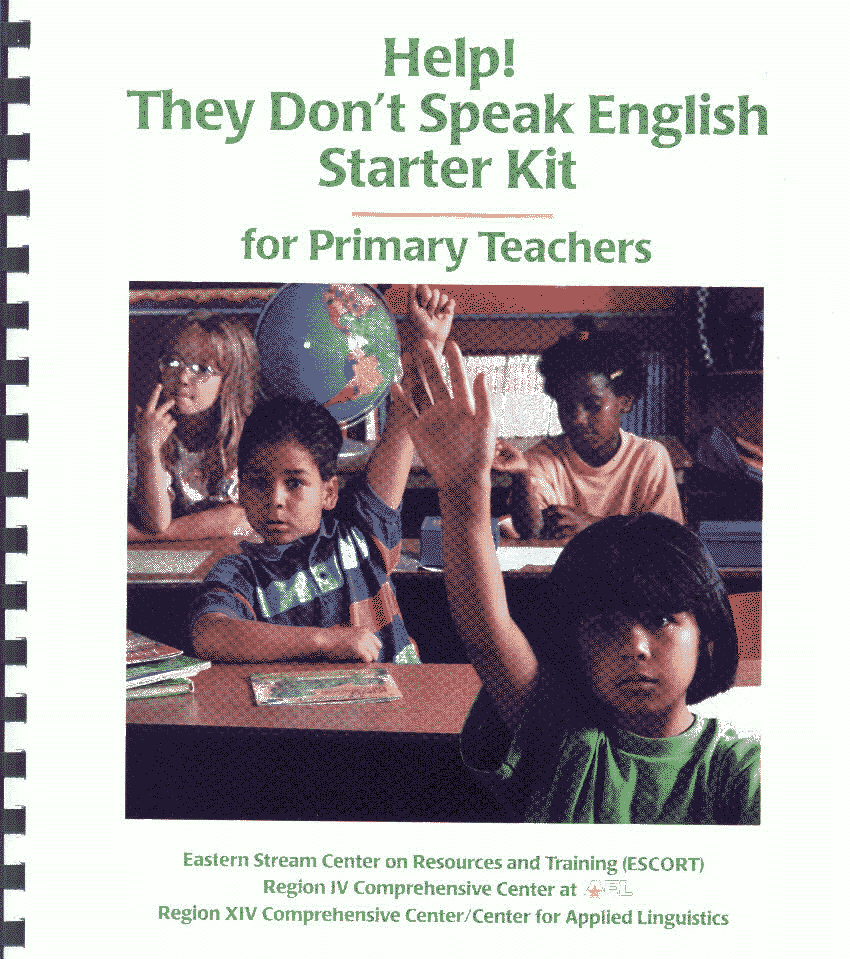|
Chapter 1 |
|
1. Riddlemoser,
N. (1987, November). Working with limited-English proficient
students in the regular class-room. Washington, DC: ERIC
Clearinghouse on Languages and Linguistics, Center fo
r Applied
Linguistics. *ED289368 |
|
2.
Menchaca, V.D., & Ruiz-Escalante, J.A. (1995). Instructional
strategies for migrant students (Report No.EDO-RC-95-10).
Charleston, WV:ERIC Clearinghouse on Rural Education and Small
Schools, Appalachia Educational Laboratory. |
|
3. Garcia, E.E. (1997, March). The education
of Hispanics in early childhood: Of Roots and Wings. Young
Children, 5-14. (Copyright 1997 by Eugene Garcia-see inside
front cover for information on right and permissions. [Volume,
52, Number 3]) |
|
4.
Dale, T.C. (1986, December). Limited-English-proficient students
in the schools: Helping the newcomer.
Washington, DC: ERIC
Clearinghouse on Languages and Linguistics, Center for Applied
Linguistics. |
|
Chapter 2 |
|
1. Whittaker, C. R., Salend, S. J., &
Gutierrez, M. B. (1997, March). Voices from the fields: Including
migrant farm workers in the curriculum. The Reading Teacher,50(6),482-493.(Copyright
1997 International Reading Association) |
|
2. Sutton, C. (1990, Summer). Oral language
development -- Common sense strategies for second language learners
in the primary grades. Elementary ESOL Education News,
13 (1), 1- 2. |
|
3. Kagan,S.(1
995,May). We can talk: Cooperative
learning in the elementary ESL classroom. Washington, DC:
ERIC Clearinghouse on Languages and Linguistics, Center for Applied
Linguistics. (ERIC Document Reproduction Service No. EDO-FL-95-08) |
|
4. Jacob, E. & Matson, B. (1987, September). Cooperative
learning with limited-English-proficient
students. Washington,
DC: ERIC Clearinghouse on Languages and Linguistics, Center for
Applied Linguistics. *ED287314 |
|
5. First, C.A. Nations, M. J. I Thrush, E. A.
(1990, Summer). Tips from the trenches -Sample learning center
activities. Elementary ESOL Educatjon News, 13 (1), 3-5. |
|
Chapter 3 |
<
/TR>
|
1. Samway, K. D., & Taylor, D. (1993,
Spring). Inviting children to make connections between reading
and writing. TESOL Journal,7-11. |
|
2. Hamayan, E. V (1989, Summer).Teaching writing
to potentially English proficient students using whole language
approaches. Program Information Guide Series, 11. Silver
Spring, M
D: National Clearinghouse for Bilingual Education. |
|
Chapter 4 |
|
1. Crandall, J. (1994, January). Content-centered
language learning. Washington, DC: ERIC Clearing-house on
Languages and Linguistics, Center for Applied Linguistics. (
ERIC
Document Reproduction Service No. EDO-FL-94-06) |
|
2 . Tang, G.M. (1992-1993, Winter). Teaching
content knowledge and ESOL in multicultural class-rooms. TESOL
Journal, 2(2). Reprinted by permission in TEACH:
Session 3-Study Guide Appendix, 209-214. |
|
3. Reilly, T. (1988, May). ESL through
content-area instruction. Washington, DC: ERIC Clearinghouse
on Languages and Linguistics, Center for Applied Linguistics.
ED406847 |
|
Chapter 5 |
|
1. Short, D.J.& Spanos,G. (1989, November).
Teaching mathematics to limited English proficient Students.
Washington, DC: ERIC Clearinghouse on Languages and Linguistics.
Center for Applied Linguistics. *ED317086 |
|
2. Corwin, R.B. Brahier, D.J., & Speer, W.R.
(1993, February). Ideas. Arithmetic Teacher. 40 (6),
325-332. |
3. Capps, L. R. & Pickreign, J. (1993, September).
Language connections in mathematics: A critical part of mathematics
instruction. Aritbmetic Teacber, (41)1, 8-12. |
|
Chapter 6 |
|
1. Tannenbaum, J
. (1996, May). Practical
ideas on alternative assessment for ESL students. Washington,
DC: ERIC Clearinghouse on Languages and Linguistics, Center for
Applied Linguistics. (ERIC Document Reproduction Service No.
EDO-FL-96-07) |
|
2.
Derrick-Mescua, M. ( ). Assessment that supports academic success
for English language learners. In
From Theory to Practice.
Tampa, FL: Region XIV Comprehensive Center. |
|
3. Hoyos, C. (1 996, January/February). Help
your students beat the testing. Instructor, 60-65. |
|
Chapter 7 |
|
1. Holman, L.J.(1997,April). Working
eff
ectively with Hispanic immigrant families. Phi Delta Kappan,
648-649. |
|
2. Villarreal, A. (1996, February 1).
Parents as first teachers: Creating an enriched home learning
environment. NABE News, 13-17. |
|
3. Martin, P (1994). Migrant farm wo
rkers and
their children (Report No. EDO-RC- 94-7). Charleston, WV:
ERIC Clearinghouse on Rural Education and Small Schools, Appalachia
Educational Laboratory. |
|
4.
Valent-Sciences, E., Sutton, C. P 7 Ware, H. W (1991). Fostering
home-school cooperation: Involving language minority families
as partners in education. Washington, DC: Na
tional Clearinghouse
for Bilingual Education. |
|
Chapter 8 - no articles cited |
|
Chapter 9 is the chapter you are
currently viewing. |

